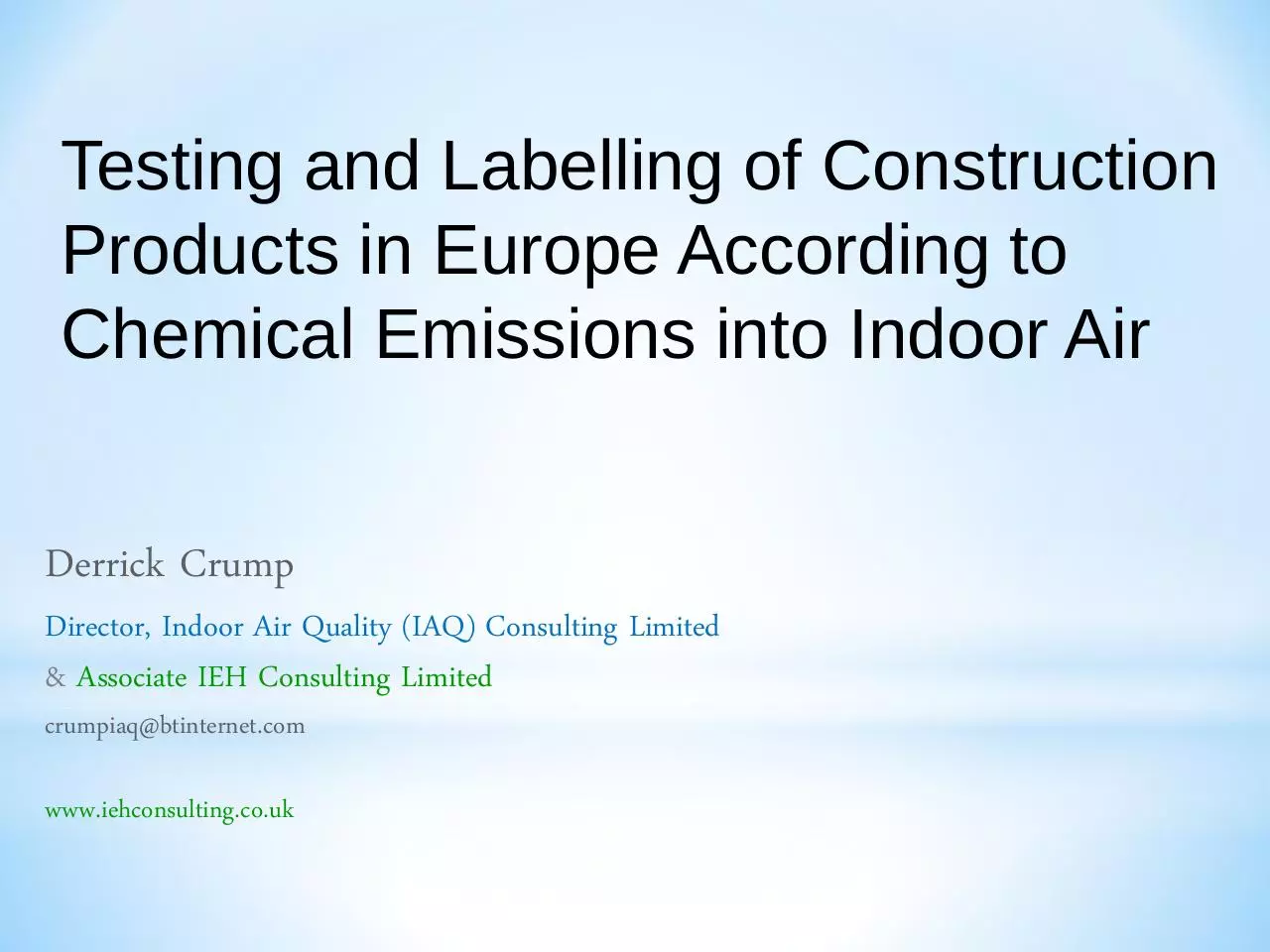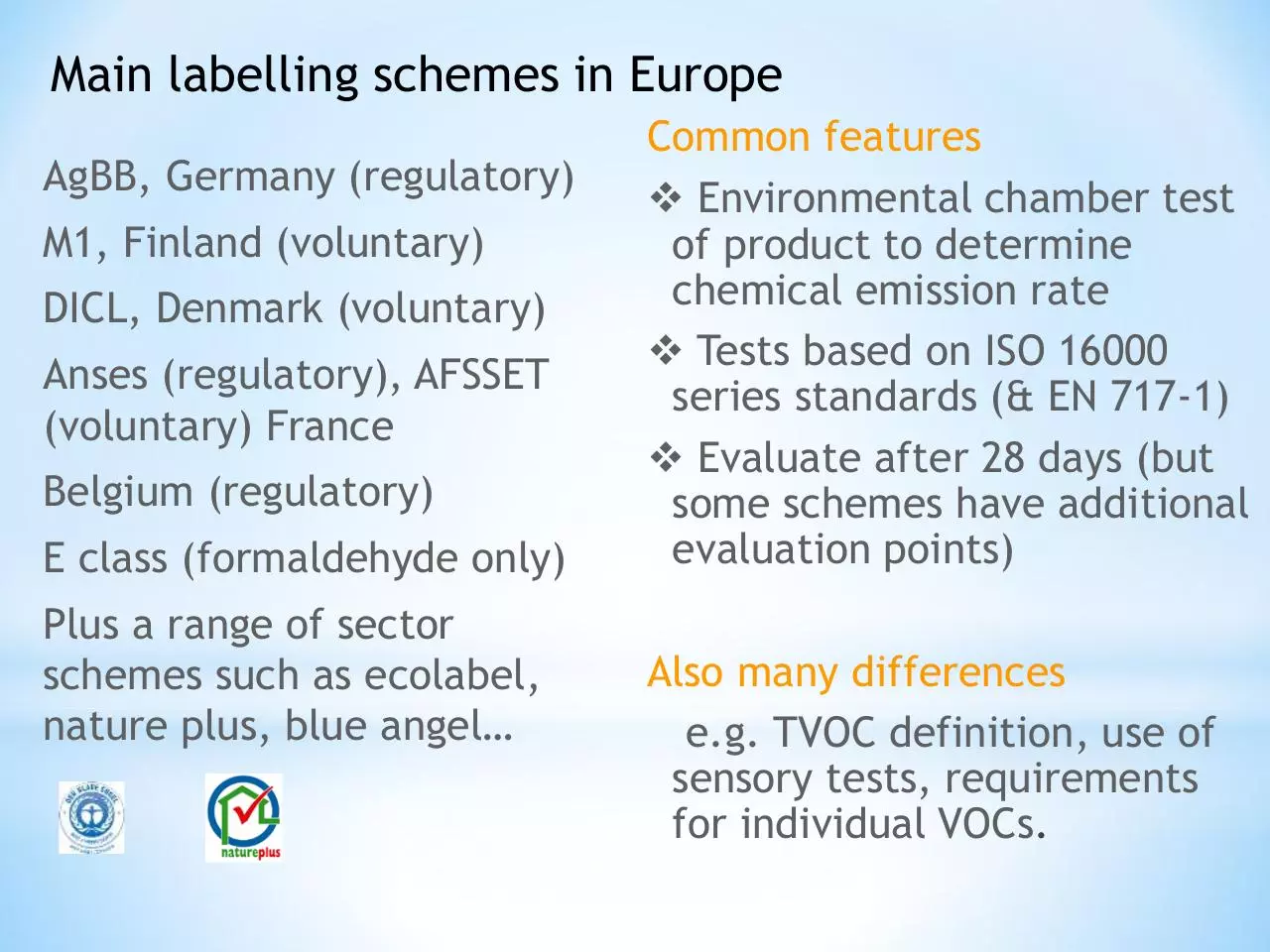Derrick Crump, UKIEG Healthy Buildings, ASBP (PDF)
File information
Title: Presentation Title 30pt Date, defused light 20pt Presenter’s Full Name, defused light 16pt Position, defused light 16pt
Author: BT01AEA
This PDF 1.5 document has been generated by Microsoft® PowerPoint® 2013, and has been sent on pdf-archive.com on 21/01/2016 at 11:51, from IP address 82.40.x.x.
The current document download page has been viewed 684 times.
File size: 917.37 KB (27 pages).
Privacy: public file





File preview
Testing and Labelling of Construction
Products in Europe According to
Chemical Emissions into Indoor Air
Derrick Crump
Director, Indoor Air Quality (IAQ) Consulting Limited
& Associate IEH Consulting Limited
crumpiaq@btinternet.com
www.iehconsulting.co.uk
Indoor pollutant concentration
Concentration of pollutant indoors depends on level in
outdoor air, release into indoor air, removal by ventilation,
sorption to surfaces and reactions.
*
Control of sources
Initiatives on source
Therefore…. source control
combined with appropriate
ventilation with ‘fresh’
outdoor AQ achieves good IAQ
control are dominated by
national schemes; primarily
construction products
National schemes act as
barriers to trade, and a
multitude of schemes
confuse consumers
Construction, consumer and
furnishing products are an
important source of organic
vapour phase emissions
Historically many technical
associated with IAQ problems and political challenges to
in buildings;
harmonisation across
Europe:
VOC, VVOC (including
- test methods
formaldehyde), SVOC
- data evaluation
Also Ammonia.
Main labelling schemes in Europe
AgBB, Germany (regulatory)
M1, Finland (voluntary)
DICL, Denmark (voluntary)
Anses (regulatory), AFSSET
(voluntary) France
Belgium (regulatory)
E class (formaldehyde only)
Plus a range of sector
schemes such as ecolabel,
nature plus, blue angel…
Common features
Environmental chamber test
of product to determine
chemical emission rate
Tests based on ISO 16000
series standards (& EN 717-1)
Evaluate after 28 days (but
some schemes have additional
evaluation points)
Also many differences
e.g. TVOC definition, use of
sensory tests, requirements
for individual VOCs.
Test Method
Start of harmonised emission testing –
1989 – HCHO from wood based products
Conditions 1ach, 23˚C, 45%RH
Loading ratio of 1 m2 m-3
Determine ‘steady state’
formaldehyde concentration in
chamber
Minimum test period of 10 days and
maximum of 28 days
Evolved into standard EN 717-1
primarily for wood based products
Construction Products Directive/ Regulation
CPD - European Council
Directive 89/106/EEC
Essential Requirement No.3;
Hygiene, Health and the
Environment
A healthy indoor environment
can be achieved by controlling
sources and eliminating or
limiting the release of
pollutants into the air
Superseded by CPR in 2013
CEN/TC 351 mandated in 2006
to prepare harmonised EN
standards.
BS EN ISO 16000-9 & 10; 2006
23˚C, 50%RH
Requirements for control
of conditions and recovery
of released chemical
Minimum requirement for
sampling of chamber / cell
after 3 and 28 days
Determine VOC emission
rate per area product
Informative annex
defining model room (17.4
m3, 0.5 ach-1) and area
specific air flow rate for
product types
BS ISO 16000-6: 2011
VOC active sampling, thermal
desorption and gas
chromatography using MS or MSFID
Normative part requires use of
Tenax TA adsorbent tube
TVOC (FID &/or MS)(C6-C16),
toluene equivalent
Identify as many compounds as
possible, particularly those
representing the 10 highest peaks
Informative annex on
measurement of VVOC (<C6) and
SVOC (>C16)
Annex lists over 200 VOCs
present in indoor air
Download Derrick Crump, UKIEG - Healthy Buildings, ASBP
Derrick Crump, UKIEG - Healthy Buildings, ASBP.pdf (PDF, 917.37 KB)
Download PDF
Share this file on social networks
Link to this page
Permanent link
Use the permanent link to the download page to share your document on Facebook, Twitter, LinkedIn, or directly with a contact by e-Mail, Messenger, Whatsapp, Line..
Short link
Use the short link to share your document on Twitter or by text message (SMS)
HTML Code
Copy the following HTML code to share your document on a Website or Blog
QR Code to this page

This file has been shared publicly by a user of PDF Archive.
Document ID: 0000333874.